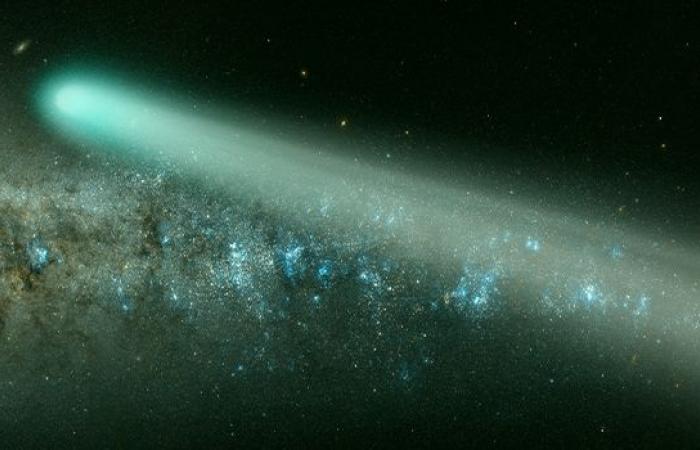The newly discovered comet ZTF is approaching its closest point to Earth in 50,000 years, becoming visible to the naked eye and making headlines. Some call it an “extremely rare” and “bright green” comet, but does it live up to the hype? Let’s explain.
Facts about comet ZTF
Comet ZTF was discovered on March 2, 2022, using a robotic camera attached to a telescope known as the Zwicky Transient Facility (ZTF). Palomar Observatory in Southern California. ZTF scans the entire northern sky every two days and captures hundreds of thousands of stars and galaxies in one shot. Many comets have been found with this instrument. The latest is C/2022 E3 (ZTF), Comet ZTF for short.
Why is it rare?
Comet ZTF has traveled 2.8 trillion miles and will reach its closest point to Earth in 50,000 years on February 1, 2023. Orbital calculations show that Comet ZTF can never return.
What makes ZTF a green comet?
The green color is probably caused by a molecule of two carbon atoms linked together, called a carbon atom decarbonized. This unusual chemical process is primarily confined to the head, not the tail. If you look at the Comet ZTF, this green is probably very faint (if visible at all). The appearance of green comets due to carbon dioxide is quite rare.
In recent photographs, the head (coma) is distinctly green, followed by an impressively long, thin tip of blush (tail). But that’s what a camera that takes a long exposure sees. The shade looks less green to the naked eye.
When and where you can see it Comet ZTF
From the second half of January to the beginning of February, the ZTF can become bright enough to be visible with the naked eye. Use a reliable star chart to track the night-to-night changes in the background’s position relative to the stars and constellations. Here are the approximate dates and locations.
January 12-14
Look toward the constellation Corona Borealis just before sunrise.
January 14-20
Look toward the constellation Boötes just before sunrise.
January 21
The comet will be visible in the night sky (previously it was only visible in the early morning hours). Look north, above Göncöl and to the left.
January 22-25
Look near the constellation Draco (the Dragon).
January 26-27
Look a few degrees east of the small glove bowl. On the evening of the 27th, it will be about three degrees in the upper-right corner of orange Kochab, the brighter of the two outer stars in the Little Dipper bowl.
January 29-30
Look towards Polaris.
February 1
Look near the constellation Camelopardalis.
February 5
Look toward the bright yellow-white star Capella (from the constellation Gemini).
February 6
Look into the triangle known as Auriga’s ‘Children’ star pattern around 8pm local time.
February 10
Look two degrees to the upper left corner of Mars.
Note: If you live in a large city or a distant suburb, seeing this comet will be a difficult – if not impossible – task. Even for those blessed with a dark, starry sky, finding the ZTF can be a serious challenge.
Watch the ZTF comet live now:
More information about the ZTF offer
As for tails, comets can eject two types, dust and gas. Dust eyes are much brighter and more spectacular than gas tails because dust reflects the sun’s rays very effectively. The coolest comets are dusty and create long, bright tails that make for a stunningly beautiful celestial sight.
On the other hand, the gas tail appears dimmer and glows with a bluish hue. The gas is activated by the sun’s ultraviolet rays, causing the tail to glow in the same way that phosphorescent paint does under black light. Unfortunately, the gas tails produced by most comets appear to be long, thin, light, and rather faint. It’s stunning in pictures, but depressing. And this is what we are seeing now at ZTF.
Finally, when the ZTF is at its peak in late January and early February, it has to compete with another celestial body: the Moon. In the same time frame, the Moon will be close to its full phase (The Snowy Full Moon on February 5th). A full moon blazing like a huge spotlight in the night sky makes it much more difficult to see a relatively dim and scattered object like Comet ZTF.
Other comets can be viewed
About a dozen comets are visible in the night sky tonight. However, most of these telescopes are only visible with large format telescopes. You’ll also need a good star atlas and the exact coordinate positions so you know where to point your device to see these things. Most amateurs who hunt for them call such comets “faint fuzz,” because that’s pretty much what they look like through a lens: a faint, fuzzy point of light. These are called “ordinary comets”.
Every now and then, maybe two or three times in 15 or 20 years, a bright comet or “big comet” appears. These are the ones who amaze us who don’t have binoculars or a telescope – all you have to do is get out, look up and shout, “Look that!Such comets are usually much larger than average. Most of these with cores or cores are less than two to three miles wide. But there are other things that can reach multiples.
As a general rule, the closer a comet is to the Sun, the brighter it will be. The big ones, which sweep closer to the Sun than the distance to Earth (92.9 million miles), are usually very bright. Comet Hale-Bopp in the spring of 1997 and Comet Niues (discovered by an automated space telescope) in the summer of 2020 are good examples.
So which category does ZTF fall into? In many ways, this is a fairly common comet, but compared to most other obscure marriages, the ZTF is very bright.
Related articles
Comets, asteroids and meteorites – the difference between them
January night sky guide
Join the discussion
Are you looking up at the sky for the “green” comet ZTF?
Let us know in the comments below!






